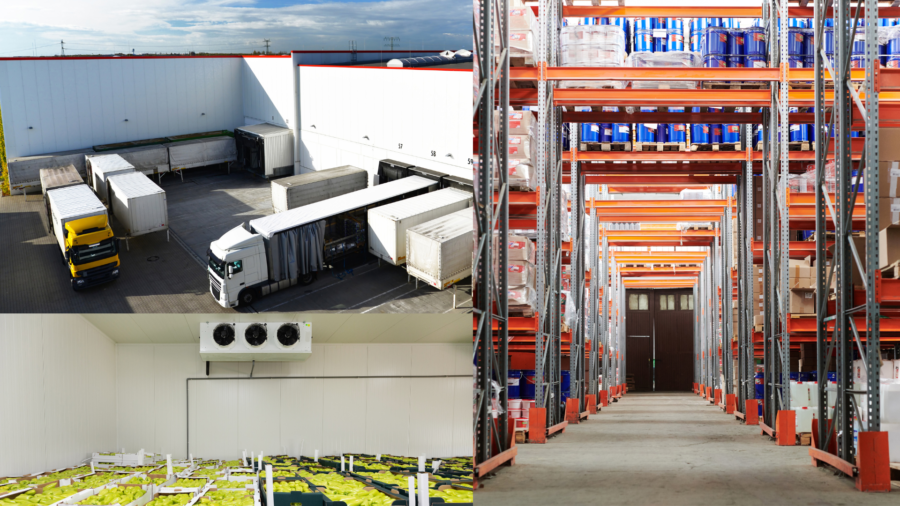Warehouses: Storage and Distribution

Warehouses: Storage and Distribution
A warehouse can range anywhere from 50,000 square feet or even less, all the way up to hundreds of thousands of square feet, depending on the location and its use. These buildings are typically only one story and can be up to 60 feet tall to accommodate goods storage. Equipment must have the ability to move about freely for inventory to be transported to vendors. Certain warehouse buildings may also offer office space for business operations, but the bulk of the facility is used for storing goods.
Warehouses also usually have large concrete truck courts to accommodate frequent traffic from 18-wheelers and large box trucks. Warehouses and distribution centers are essentially large, square, or rectangular boxes with loading docks.
Warehouse properties are all about how products are moved around and ultimately sent to an end-user. Size can vary depending on the type of property.
General Purpose Warehouse
These warehouses are more geared toward storage than distribution. That difference can play out in several ways. For example, most general-purpose warehouses have a lower door to square footage ratio, since products aren’t being moved in and out as often. It also means that location matters less than what’s being stored there, which is what drives most of the variation in these spaces. For instance, one subset of general-purpose warehouses is cold storage facilities, which are equipped with freezers and generally used to store perishable food items. General purpose warehouses may be one or multiple stories (with the addition of “mezzanine” levels), and could have small office or showroom spaces, but their general purpose is to hold items for storage or for reshipment.
Distribution
Bulk distribution warehouses are ideal for tenants such as logistics and distribution companies who need to ship goods to businesses or consumers.
They also have lower parking ratios than other types of industrial buildings because there are usually fewer employees working in these spaces and little (or no) customer traffic.
Location is key for distribution because most product is moved through truck transportation. These buildings are usually located on or near major interstates and thoroughfares to allow for ease of access to ensure fast connection to major cities. Depending on how tenants receive and distribute goods, airport proximity can also be a factor in the site selection process.
Some warehouse buildings are used by tenants with specialized needs such as manufacturing, cold storage, and data centers. More on these specialized warehouses later in the lesson.
Truck Terminals/Cross-Dock
On the other end of the spectrum from general-purpose warehouses are truck terminals, which are entirely devoted to transportation. These are simply intermediate sites where goods are loaded from one truck to another, facilitating the movement of goods along the supply chain with little to no capacity for storage.
Cold Storage/Refrigeration
Cold storage and refrigeration warehousing is exactly what it sounds like: refrigerated warehousing intended to store perishable food and products.
Cold storage is a very specialized form of industrial, used primarily by food manufacturing and distribution companies, as well as pharmaceutical companies who need to keep their goods at cooler temperatures. Cold storage facilities can also be used to hold artwork. Refrigeration and cold storage industrial buildings are equipped with storage or freezer space to manufacture and distribute food products. Cold storage buildings often lease to single tenants on a net lease, such as large national food distribution companies.
INSIGHT: A net lease is when a tenant is required to pay a portion of the operating expenses and other expenses in addition to the base rent.
These special-purpose facilities have incredibly high utility demands and therefore, can be costly to own and operate unless leased to a national credit tenant (e.g., Sysco Corporation).
Also, cold storage industrial buildings are often used as distribution centers for grocery chains, requiring HVAC systems and insulation setups that can support and maintain temperatures ranging between 34 degrees to -10 degrees.
Many perishable food products require access to refrigerators and freezers to keep food fresh for human consumption. These buildings can be around the same size as traditional warehouses and will also offer access to the trucks and machinery needed to get the products onto shelves.
Like heavy manufacturing sites, these spaces require extensive build out so tenant retention can be very high.
Cold Storage: The Hot New Asset Class
Food Grade Storage
Food grade storage is a special type of warehouse that meets higher standards set by the Food and Drug Administration. Among other requirements, they usually meet high levels of cleanliness, have integrated pest management systems, and follow different cleaning and maintenance protocols. Pharmaceutical grade warehouses are like food grade properties, but typically meet even higher standards.